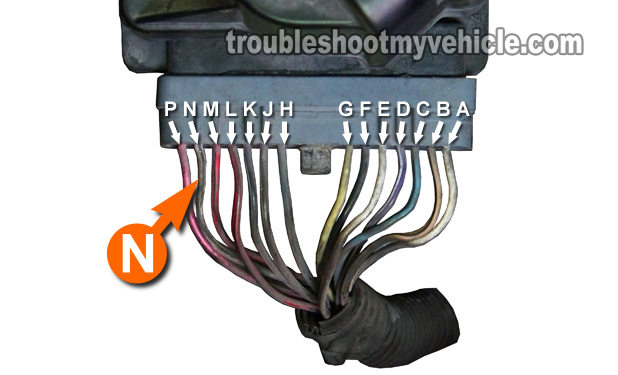CKP TEST 2: 18X Signal

Testing for the 18X crank signal follows pretty much the same procedure you followed to test for the 3X Sync signal.
The only difference will be that your multimeter will show a faster ON/OFF voltage response since the 18X signal produces more of these ON/OFF pulses than the 3X Sync signal.
As before, take all necessary safety precautions when performing this test and do not use the starter motor to crank the engine.
IMPORTANT: The CKP sensor and the ignition control module must remain connected to their connector during the test to read the 18X CKP signal.
Let's get started:
- 1
All of the 6 fuel injectors must remain disconnected, so as to prevent fuel injection into the engine, as you hand-crank the engine.
- 2
Place the multimeter in Volts DC mode.
- 3
Connect the red multimeter test lead (using an appropriate tool) to the wire labeled with the letter G in the image above.
This wire (circuit) is the one that transmits the 18X signal from the 3X-18X crankshaft position sensor.
You can use a back probe or a wire-piercing probe. To see what a what this tool looks like, click here: Wire Piercing Probe. - 4
Connect the black multimeter test lead to the battery negative (-) terminal.
- 5
Turn the crankshaft pulley by hand in a clock-wise direction while you keep you eyes on the multimeter.
Just a friendly reminder, don't crank the engine with the starter motor. - 6
The multimeter will register an ON/OFF voltage of 5 to 6 Volts if the crankshaft position sensor is producing the 18X signal.
ON is when the multimeter displays 5 to 6 Volts DC and OFF is 0 Volts DC.
NOTE: Turn the engine slowly and steadily so that you can see this voltage change on your multimeter.
Now, let's take a look at what those voltage readings (or lack of) mean:
CASE 1: The multimeter registered the ON/OFF 5 to 6 Volts DC as the crankshaft pulley was hand-turned. This result indicates that the 3X-18X CKP sensor is creating a good 18X CKP signal and is working fine.
Now, since up this point you have confirmed that both the 3X Sync signal and the 18X signal are indeed being created and are being fed to the ignition control module, you can eliminate the crankshaft position sensor as the source of the problem.
Now, since your vehicle is still suffering a no-start condition and different things can cause it (besides a bad crankshaft position sensor), the following tutorial may offer you more troubleshooting/testing ideas:
CASE 2: The multimeter DID NOT register the ON/OFF 5 to 6 Volts DC as the crankshaft pulley was hand-turned. This result indicates that the 18X part of the CKP sensor is not working, read the following to IFs:
BIG IF #1: If in CKP TEST 1 you saw the 5 Volt ON/OFF pulses (to register on your multimeter) and in this test you got no 5 Volt ON/OFF pulses, then the crankshaft position sensor is bad and needs to be replaced. Replacing the crankshaft position sensor will solve the no-start problem.
If you do need to buy the crankshaft position sensor, take a look at my recommendations here: Where To Buy The Crank Sensor And Save.
BIG IF #2: If in CKP TEST 1 you got no 5 Volt ON/OFF pulses on your multimeter and in this test you also got no 5 Volt ON/OFF pulses, the next steps are to verify that it's getting both power and Ground. If both of these exist, then the crankshaft position sensor is bad. Go to: CKP TEST 3: Power Circuit.
CKP TEST 3: Power Circuit

Testing the power circuit that feeds the crankshaft position sensor on your 3.8L equipped Buick (or Chevrolet or Oldsmobile or Pontiac) is also done right at the ignition control module (ICM) connector, since it's the ICM that feeds the crankshaft position sensor with power.
This power is fed to the sensor in the form of 10 Volts and as in the previous test steps, you'll be using your multimeter to verify this voltage.
NOTE: The ignition module's connector must remain connected to the ignition module for this test to work since it's the ignition module that provides this power to the crankshaft position sensor.
This is what you need to do:
- 1
Place the multimeter in Volts DC mode.
- 2
Connect the red multimeter test lead (with an appropriate tool) to the wire labeled with the letter N in the image above.
NOTE: The ignition module must remain connected to its electrical connector to read the 10 Volts. - 3
Connect the black multimeter test lead to the battery negative (-) terminal.
- 4
Have an assistant turn the key to the ON position inside of the car or mini-van.
You don't need to crank the vehicle for this test, since voltage will be present with just the key in the ON position. - 5
Your multimeter will display 10 Volts DC if the wire is delivering power to the CKP sensor.
Now, let's take a look at what those voltage readings (or lack of) mean:
CASE 1: The multimeter showed 10 Volts when the ignition was turned ON. This multimeter result confirms that the ignition control module (ICM) is providing the crankshaft position sensor with power.
The next test is to verify that the ignition control module is providing a good Ground path to the 3X 18X CKP sensor. So, go to: CKP TEST 4: Ground Circuit.
CASE 2: The multimeter DID NOT show 10 Volts when the ignition was turned ON. This result indicates that the ignition module is not supplying power to the crankshaft position sensor.
This result exonerates the crankshaft position (CKP) sensor as the cause of the cranks but does not start condition you're trying to solve, since without these 10 Volts, the crankshaft position sensor can not create a signal.
